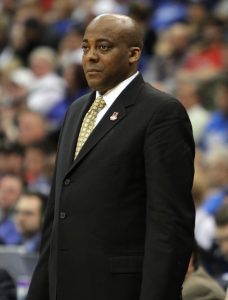Notice: Undefined offset: 1 in /var/www/wp-content/themes/jnews/class/ContentTag.php on line 86
Notice: Undefined offset: 1 in /var/www/wp-content/themes/jnews/class/ContentTag.php on line 86

By Roscoe Nance, For TheAfricanAmericanAthlete

The NCAA Playing Rules Oversight Panel has approved a proposal to move the three-point line to the international distance of 22 feet 1 ¾ inches which, is 1 ¾ inches back from the 20 feet 9 inches it has been for the past 10 seasons.
But don’t look for sharpshooters to pull up and fire from farther out on the floor during the 2019-2020 college basketball season. That’s the thinking among several HBCU coaches who say that because the longer shot is available doesn’t mean teams will take it.
“I think you will see more driving lanes open up,’’ says Arkansas-Pine Bluff coach George Ivory. “I don’t think you’ll see a whole lot more threes right of the bat. You could. But I really think it’s going to open up more driving lanes. If you do have teams that can shoot it from that distance, it will be an advantage. But it’s a couple of feet back and you have to guard the line. It’s going to open up the game a lot more and create scoring opportunities.’’
The panel also adopted three other rules changes. The shot clock will recycle to 20 seconds following an offensive rebound instead of 20; coaches will be allowed to call live-ball timeouts in the final two minutes of the second half and overtime periods, and technical fouls will be assessed against any players using, “derogatory language about an opponent’s race, ethnicity, national origin, religion, gender, gender expression, gender identify, sexual orientation or

disability.”
The change in the distance for three-point line applies only to Division I men for the upcoming season. It will go into effect in Divisions II and III for the 2020-21 season.
The three-point shot has been part of the college basketball conversation since 1945 when it was used in a game between Fordham and Columbia. A made shot from 21 feet counted for three points in that contest, but the change wasn’t adopted.
The long-distance shot resurfaced in 1958, this time from 23 feet. It was used as a one-game experiment in a game between Saint Francis (N.Y.) and Sienna. Boston University and Dartmouth played an experimental game in 1961 in which all field goals counted for three points.
The Southern Conference in 1980-81 became the first college conference to adopt the three-point shot when it adopted a 22-foot line. Over the next five seasons, the shot was used only in conference games and conferences used varying distances for the three-point line. It was as close as 17 feet in the ACC and as far away 22 feet in the Big Sky Conference. The NCAA adopted the three-point for all games at 19 feet, 9 inches for the 1986-87 season.
The three-point shot has become the dominant weapon in college basketball in recent years. The number of long-distance shots trended upward over a four-year period through the 2017-18 season when the percentage of shots taken from behind the arc were at an all-time high of 37.5%. The percentage of three-pointers in the shot’s inaugural season was 15.7%; it was 32.9% for the 2013-14 season.
“I really don’t think it will impact the game negatively at all,’’ says first-year Mississippi Valley State coach Lindsey Hunter, who was one of the top three-point shooters in the NBA career during his 17-year pro career. “Guys who can step out and shoot it will be a little more sure of themselves, and guys who aren’t comfortable taking that shot a foot and half back hopefully it will motivate them to get in the gym and work more.’’

At the end of the day, however, the goal of the change is to create better spacing and eliminate congestion in the lane because perimeter defenders will have to cover larger areas of the floor. That concept is similar to what’s happening in the NBA, where the three-point line is a variable distance. It ranges from 22 feet in the corners to 23 feet, ¾ inches behind the top of the key.
“Hopefully it will open the game up. I know it’s college basketball but you can do lot more things as for as being in zone (defenses),’’ Hunter says, “and not being in illegal defense situations. You want it to remain its own entity as far as being college basketball.
“But you want it to emulate the highest level as close as possible without totally being that. I think that’s what is happening. It’s absolutely a good thing. A lot of college players aspire to be NBA players. You want them to have a little sense of what it could be like to play on that next level.’’
Resetting the shot clock to 20 seconds rather than 30 following an offensive rebound is also a page from the NBA playbook, where the 24-second clock recycles to 14 on an offensive rebound. The change will improve the pace of the game. Since offensive teams will already have the ball in the frontcourt the extra 10 seconds they are allowed to advance the ball across midcourt is not needed and will lead to quick shots. “It makes sense,’’ Hunter says.

